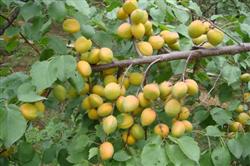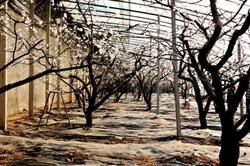Growth and fruiting habits and pruning points of Kernel Apricot

1. Growth and fruiting habits of kernel apricot: 1. Weak branching ability: several long branches are produced after kernel apricot planting. After entering the fruiting stage, these long branches are rarely branched, and the natural growth often shows insufficient branches. 2. High germination rate: most of the long shoots of kernel apricot can germinate, only a few buds at the base form latent buds, and the long branches are easy to form clusters of flower branches, and these flower branches bear fruit year after year and extend outward to maintain a balanced growth state. 3. The fruit of bouquet-shaped fruit branches and short fruit branches are the main fruit. 4. the life of the fruiting branch is short, it is easy to die, the fruiting part is easy to move out, which leads to the surface of the fruit, and the flower bud of kernel apricot is pure flower bud, and the bud position dies and can not be retracted and renewed. 5. The dryness is strong, and it is easy to appear the phenomenon of upper strength and lower weakness. 6. Buds are precocious and can germinate many times in the annual growth cycle, and secondary and tertiary branches are easy to appear. Improper control and light deterioration are easy to occur. 7. The reaction of sprouting and growing branches of cutting buds is irregular, and competitive branches are easy to appear. 2. The main points of shaping and pruning: 1. Shaping: the natural growth of kernel apricot is mainly round head shape, and the artificial cultivation should be free spinning shape, which is helpful to overcome the deficiency of strong middle stem, strong upper and weak bottom, and maintain the balanced growth of the tree. When free-spinning pruning is adopted, the trunk height is generally fixed 80-90cm, 15 main branches are left in the whole tree, no lateral branches are left on the main branches, the main branches are evenly distributed on the trunk, and the spacing between the main branches is about 20cm. The sparse layer shape of small crown can also be used, but the phenomenon of upper strength and lower weakness should be prevented during plastic surgery. 2. Pruning: the main points of pruning in the young tree stage: (1) make full use of the prematurity of buds and accelerate the formation of secondary branches. Kernel apricot grows vigorously in the young tree stage, and the buds on the new shoots can germinate in the same year to form secondary and tertiary branches. during pruning, in addition to lengthening the head of the backbone branches, the stout secondary branches in the middle and upper part of the shoots are selected to increase branches, accelerate formation, increase coverage, improve light energy utilization efficiency, increase photosynthate accumulation, and facilitate preterm production. (2) throwing long branches to promote the formation of flower buds. After the long branches of kernel apricots are thrown away, it is easy to form short fruit branches with balanced power, forming clusters of flower branches, while kernel apricots are mainly short fruit branches, and flower branches are the main fruiting parts, so the long branches that are not used for plastic surgery should be thrown more and less short stimulation should be made. to promote the formation of flower buds and promote the early production and early yield of kernel apricots. (3) pay attention to the culture branch group. When culturing the fruiting branch group, the corresponding branch group should be cultivated according to the space size, which can promote the formation of the branch group by slowly releasing the long and strong branches, and can also cut the thin and weak branches to promote the formation of the branch group. (4) it is necessary to control the competitive branches and prevent the tree from being disturbed. Kernel apricot should pay attention to control the competitive branches in the young tree stage, which can be controlled by the combination of sprouting in the growing season and thinning branches in winter pruning. Where there is space, the competitive branches can be transformed into fruiting branches by twisting and pulling branches. The main points of tree pruning during the full inspection period (1) strengthen the renewal of fruiting branches and maintain exuberant fruiting ability. The new shoots with a total branch amount of 1 / 3 per year can be removed from the senescent branches that have borne fruit for many years and keep the strong branches bearing fruit so as to keep the yield stable. (2) to strengthen the renewal of flower branches. Although the flower branches of kernel apricot can bear fruit continuously for many years, when the fruiting time is long, the short branches become weaker, the number of fruit becomes less, which is disadvantageous to the improvement of quality. Therefore, after 5 years of fruiting, it should be retracted or thinned in time to promote the formation of a new fruiting unit and improve the fruiting ability. Kernel apricot flower branches in the retraction, it is best to retreat to the back part of the branch or the base of the latent bud, in order to promote the formation of new branches. (3) it is necessary to strengthen the transformation and utilization of the long branches of students. In the late growth stage of kernel apricot, dead branches increase, and the overgrown branches in the inner chamber of the crown should be fully utilized, which can be changed into clusters of flower branches by means of slowly releasing and pulling branches, so as to promote fruit, prolong the fruiting life of the tree and improve the overall production efficiency.
- Prev

Installation of apricot trees to grasp "ten tubes"
Because of its cold and drought tolerance, most apricot trees are planted on slopes with poor ridges, and because their roots are strong and spread all over the garden, it is difficult to ploughing and ploughing. In addition, the standard of soil preparation is not high, which often results in soil consolidation and poor permeability. prone to soil-borne diseases (such as root rot), difficulties in fertilization, hard ploughing and other phenomena.
- Next

Methods of increasing walnut yield
Methods of increasing walnut yield
Related
- Moge, come on! The staff of the peasant association in the producing area of cantaloupe were frightened when the crowd gathered.
- Causes and Solutions of low Fruit setting rate of Apple
- Symptoms and control measures of passion fruit virus disease
- Fruit growing lesson: how do apple orchards keep high yields?
- Can you build orchards in the mountains? What are the pros and cons?
- How to manage the coloring period of Crisson grape?
- This paper introduces the processing technology of two kinds of fig products.
- How much is a month for retired teachers in rural areas by 2020?
- How can strawberry planting increase sugar content? We should pay attention to management in many aspects.
- What are the cultivation techniques on how to improve the yield of golden fruit?

